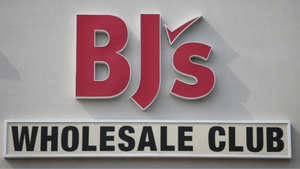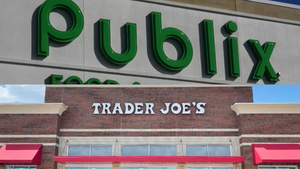Smaller is better: Sprouts Farmers Market finds success in reduced store footprintSmaller is better: Sprouts Farmers Market finds success in reduced store footprint
Other retailers are also leaning into smaller formats, and analysts say the trend should continue in the coming years

The success of Phoenix, Ariz.-based Sprouts Farmers Market over the last year is undeniable.
The organic and natural food grocery retailer has posted a string of positive earnings reports, with the latest from Q2 indicating $1.9 billion in net sales, which is a 12% year-over-year increase, as well as comparable stores sales growth of 6.7%.
Wall Street is responding accordingly. On Oct. 22, the share price for Sprouts reached an all-time high of $118.
The success is the result of bold moves from Sprouts in choosing to both focus on health conscious shoppers, as well as lean into a smaller store footprint.
The plan to turn towards the health-focused consumer strategy meant a sacrifice— focusing on a concentrated 200 billion shoppers, which in turn cost the retailer over 500,000 customers, according to Sprouts CEO Jack Sinclair.
“We decided to focus on the 200 billion, the health enthusiasts, and when you become more focused on that, it changes what you do in merchandising,” Sinclair said at the Goldman Sachs Global Retailing Conference in September.
Store size has also played a role. Sprouts is no longer laying out its store footprint over 32,000 square feet, instead choosing to operate under tighter conditions—20,000 to 25,000 square feet. The grocer calls it “tighter box economics.”
“When we really got into it, we found ourselves putting elements inside the store that customers didn’t really care about,” said Dan Croce, Sprouts senior vice president of Real Estate and New Store Development. “Obviously being 20 to 25,000 square feet as opposed to 25 to 32,000 square feet just opens the door for more opportunity for us.”
According to Croce, Sprouts discovered that department efficiencies went a long way in supporting the tighter box economics, which meant product assortment, a staple for the grocer, was not sacrificed.
“It’s healthy space allocation,” said Croce. “And what I mean by that is understanding our assortment where it stops in the space necessary to facilitate that assortment and positioning it with the appropriate adjacencies inside the store.”
Croce said produce is the heartbeat of the business and is positioned front and center in the store. The frozen food section, located between non-perishables and beer and wine near the front of the store, has also been booming for Sprouts. Meanwhile, the meat department was moved up front to where bakery was previously located, and fresh baked goods were positioned more towards the back of the store.
“We’re actually seeing more business come out of the bakery in our new format as opposed to the older one,” Croce.
It’s a process that involves listening to the customer and going through some trial and error, Croce said.
Sprouts additionally has an innovation center located inside every store where new products are tested. If they perform well, they become part of the regular assortment, but if sales are off, the item gets dropped.
All these new strategies are equating to higher foot traffic. During the first quarter of 2024, visits were up in Sprouts stores—13.3% year over year in February and 11.9% in March—according to data from Placer.ai.
“It’s an interesting strategy that [Sprouts] basically decreased the number of customers that they had,” said R.J. Hottovy, head of Analytical Research at Placer.ai. “The visitation trends they do have generally outperform their peers. The frequency numbers are pretty strong.”
Sprouts is not the only grocery retailer which is finding success in downsizing. Whole Foods Market launched its “Daily Shops” concept in March and now has two stores in New York City. The format ranges between 7,000 and 14,000 square feet. West Des Moines, Iowa,-based Hy-Vee has said it sees its Fast & Fresh concept (10,000 square feet) as a growth engine.
Of course, some grocers were founded on smaller store formats, like Aldi and Trader Joe’s, and Hottovy said that success has not gone unnoticed.
Smaller stores are not only popping up in the grocery industry, either. Hottovy said since the pandemic stores in home furnishing, home improvement, and consumer electronics have all decreased location square footage.
“I do think that there’s going to be more and more grocers who explore this concept [of smaller stores], especially as what we are seeing is right now consumers are willing to shop a wider number of locations to fill out their basket,” Hottovy said.
Sprouts certainly is not turning back. Croce said all stores moving forward will be around 20,000 to 25,000 square feet, which makes choosing locations easier.
“Our CEO wants to bring the brand from sea to shining sea, and as we think about available real estate … it allows us to be much more nimble,” Croce said.
Loblaw’s new look
Small format isn’t just limited to the U.S. Canadian retailer Loblaw Companies Limited is trying to address two issues under one roof: grocery food inflation and the cost to run a store.
The retailer started a pilot in August with three stores under its new smaller format No Name banner. The locations range in square footage of 11,000 to 15,000 square feet and offer just 1,300 SKUs which will be 20% less than the regular retail price at any other discount grocer in the area.
The retailer says the stores will reduce operating costs in a number of ways, including:
Shorter operating hours (10 am-7 pm)
Smaller assortment means the store is less complicated to run
Limited marketing and no flyers
No refrigeration (no dairy or fresh meat products)
Reused fixtures — shelves, cash lanes — to minimize building costs
Fewer weekly deliveries, reducing logistic costs.
“We chose 1,300 of the most relevant SKUs,” said Melanie Singh, president of Hard Discount at Loblaw Companies Ltd. “It has produce, it has bakery, it has diapers, it has some frozen, but you can get quite affordable products there.”
If successful, Loblaw plans to roll out more No Name store formats.
When it comes to Spouts, Dan Croce says small is the ultimately Goldilocks solution for the grocer.
“We’re pretty rigid [around the small-format store]. Again, it starts and stops with the customer,” said Croce. “They like the 20,000 to 25,000-square-foot store. It’s not too big, it’s not too small.
“I hate to say the old saying, but it’s just right in terms of our brand.”
Read more about:
Sprouts Farmers MarketAbout the Author
You May Also Like






